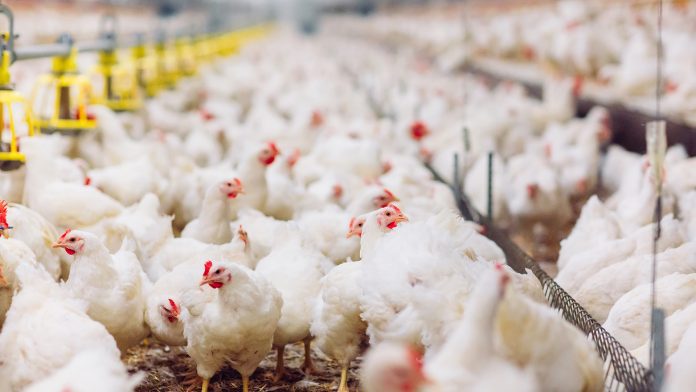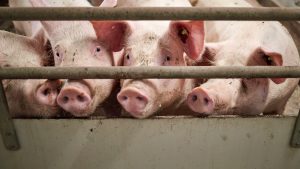
Jane Tredgett, Campaigns Manager at Alliance to Save Our Antibiotics, discusses the effects of routine antibiotic use in intensive livestock farming and why it needs to be reduced.
Antibiotic use in farming has long been a contested issue. Despite efforts to reduce antibiotic use in the industry and mitigate the growing threat of drug resistance, the world’s appetite for meat and dairy products has fuelled the global expansion of intensive farming and with that, routine mass medication of animals to prevent the potential spread of disease. Not only does this pose implications for animal welfare, but also concerns over how the industry is impacting human and environmental health. To discuss this further, Lorna Rothery spoke to Jane Tredgett, Campaigns Manager at Alliance to Save Our Antibiotics.
What is the role of CIWF in the context of AMR?
Compassion in World Farming’s Brussels office works on AMR issues at an EU level, contributing towards and building upon the progress the EU has made and advocating for ambitious measures aimed at EU and international levels.
In 2009, CIWF, Sustain and the Soil Association founded the Alliance to Save our Antibiotics (The Alliance) through which we conduct much of our work on antibiotic use.
The Alliance represents 71 medical, environmental, and animal-welfare organisations. Our aim is to reduce the overuse of antibiotics in farm animals and support a One Health approach that recognises that human, animal, and environmental health are all interconnected.
We want:
• Antibiotic use in farm animals to focus mainly on treating individual, sick animals, as opposed to mass or preventative use;
• Improved animal husbandry to ensure animals are healthier and need fewer antibiotics; and
• Greater transparency around antibiotic-use data and animal-sourced food production.
What is the link between antibiotic use in agriculture and drug-resistant infections in humans, and when was this link first suggested?
The link between farm antibiotic use and antibiotic resistance in human medicine has been a controversial topic. However, it is now widely accepted that farm antibiotic use does contribute to the antibiotic resistance crisis.
Resistant bacteria can pass from farmed animals to humans via close contact, in the food chain or via manure being spread on the land and leaching into waterways. Most antibiotic resistance in humans is caused by the human use of antibiotics, however, we know that for certain infections in humans, most of the resistance comes from farm use, and there are infections where it is a bit of both. As the World Health Organization said, ‘Antibiotic resistance occurs naturally, but misuse of antibiotics in humans and animals is accelerating the process’.
In the UK, antibiotic growth promoters were licensed for pigs and poultry in 1953, and by the late 1950s, scientists were finding evidence that antibiotic-resistant salmonella was spreading from farm animals to humans. The government established a committee in 1962 to review the issue but, far from acknowledging the issue needed to be dealt with, the Committee recommended expanding the use of antibiotic growth promoters to include use in calves.
In the mid-1960s, a dramatic increase in human infections by a strain of multi-resistant salmonella was linked to antibiotic use in calves. A new committee, the Swann Committee, reported in 1969 and concluded that overusing antibiotics in farming did pose a threat to human health. The Committee recommended some restrictions on using growth promoters but made no proposals for ending routine prophylactic (preventative) use. It took until 2006 for antibiotic growth promotion to be fully banned in the EU, and the practice continues in about 40 countries around the world.
In 2015, a review commissioned by the UK Government found that 59% of scientific studies it analysed argued that there is a link between farm antibiotic use and resistance in humans, whereas just 8% argued the opposite. It was only in January 2022 that the EU banned all forms of routine farm antibiotic use, including prophylactic group treatments.
So, evidence that farm antibiotic use can contribute to resistance in humans appeared soon after antibiotics were used at low doses to promote faster growth, but it has taken decades for significant action to be taken.
How has the global growth in intensive livestock farming, and the way animals are raised, contributed to the prevalence of antibiotic use in farming?
Meat consumption has grown dramatically in recent decades. This has led to an increase in intensified farming methods. Antibiotics are needed to control diseases caused by the unhygienic conditions created by this intensification. So antibiotic use has facilitated the growth of intensification, in turn necessitating more antibiotic use.
The COVID-19 pandemic instructions for minimising the spread of infection included social distancing and meeting outdoors. However, on factory farms, cramped, mainly indoor-intensive environments do not enable animals to socially distance to reduce disease spread.
In the UK alone one billion land animals are reared each year, about 80% in intensive farms. It only takes a glance at these systems to see the disease risks and consequent need for antibiotic use. For example:
- The average meat chicken (broiler) has less space than an A4 sheet of paper and up to 50,000 chickens can be kept in a single shed. Broilers are bred to grow quickly and are slaughtered at just five weeks old. In the 1950s, it took four months to get to the same weight;
- Piglets are weaned very early, so the sow can produce more litters, and often develop diarrhoea as a result. Piglets also have their tails docked to reduce tail biting caused by stressful conditions; and
- Dairy cows now produce three times as much as they did in the pre-antibiotic era – causing more mastitis, and their abnormally large udders they struggle to stand straight, causing foot problems.
These consequential problems of intensive farming are often treated with antibiotics. In many ways, antibiotics are used as a productivity tool in farming, and we oppose this. Higher welfare, and lower-intensity husbandry methods would help to reduce antibiotic use.

What key measures have been implemented in the UK farming industry, and further afield, to mitigate the spread of AMR? How are such measures monitored and assessed?
UK farmers have worked to voluntary reduction targets, partially motivated by the knowledge that stricter rules were being considered and have achieved a 55% decrease in antibiotic use since 2014. Campaigning by the Alliance has also contributed to many supermarkets making significant improvements to their antibiotic policies.
The European Union introduced new rules on 28 January 2022. These rules ban: routine farm antibiotic use; antibiotic use to compensate for inadequate animal husbandry/poor hygiene and; purely prophylactic antibiotic treatments of animal groups.
Outside of Europe, routine prophylactic antibiotic use remains common, although antibiotic growth promotion is being slowly phased out globally.
Sales data is generally used to assess antibiotic use, although reporting detail varies widely around the world.
Would you say current antibiotic reduction targets in the UK are ambitious enough? How does the UK compare to other European countries?
The UK is the eighth lowest user of farm antibiotics, out of 31 European countries. This is partly because of the voluntary actions taken by British farmers and because the UK has many grass-fed cattle and sheep that tend not to require high antibiotic use.
The lowest farm antibiotic users in Europe include Norway, Iceland, Sweden and Finland, countries which banned routine prophylactic use years before the EU. In these countries group treatments account for 6-31% of overall farm antibiotic use and treatment is focused on timely use in individual sick animals. In the five highest-using countries group treatments account for over 90% of antibiotic use. The EU average for group use is 86% and 75% in the UK.
These figures suggest that large reductions in antibiotic use in farming are still achievable in the UK and most of Europe. The UK should legislate to drastically reduce group treatments and limit prophylactic use.
The UK Government is currently consulting on welcome proposals for new regulations, including no routine use, no administering to compensate for poor hygiene or husbandry and limited prophylactic use. Whilst this is a positive step if implemented, it would not go as far as the EU’s rules, as there are no proposals to ban preventative group treatment or imports of animal foods produced using antibiotic growth promoters.
To achieve truly sustainable levels of farm antibiotic use, we need more health-orientated husbandry. Highly intensive animal farming promotes the spread of disease and is the main cause of high antibiotic use.
What other techniques or interventions are needed to minimise the spread of resistance between humans and animals, and in the environment?
There is an increasing global interest in the environmental issues surrounding farm antibiotic use. This is an under-researched area, and it is difficult to get data.
Up to 80% of antibiotics taken orally can be excreted in an active form, so when slurry is spread on land, a lot of antibiotic residues and antibiotic-resistant bacteria can make their way into the environment. We have clear evidence that antibiotic use in humans and farm animals contributes to higher levels of environmental resistance.
In November 2022 the Alliance, the Bureau of Investigative Journalism and World Animal Protection released new research showing that UK rivers near factory farms had high levels of bacteria resistant to antibiotics that are critically important in human medicine, although our research did not prove these farms were the source of the bacteria. We believe it is an area where more work is needed to establish the scale of the problem and how to address it.
Jane Tredgett
Campaigns Manager for the Alliance to Save Our
Antibiotics
Compassion in World Farming
https://www.ciwf.org.uk/
https://www.facebook.com/farm.animals
https://twitter.com/ciwf
https://instagram.com/ciwf
https://www.youtube.com/CIWFFOOTAGE
This article is from issue 25 of Health Europa Quarterly. Click here to get your free subscription today.










